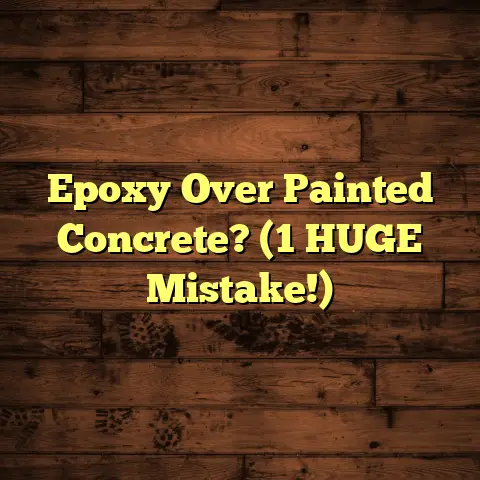Factory Floor Paint: Pro Tips & Tricks? (5 to Know!)
I get it. Factories aren’t exactly known for their dazzling aesthetics.
But what if I told you that a simple coat of paint could completely transform your factory floor, making it safer, more efficient, and even…dare I say…stylish?
I’m not talking about any old paint here.
We’re diving deep into the world of high-performance factory floor paints.
These aren’t your grandpa’s garage floor coatings.
These are engineered solutions designed to withstand the toughest conditions, from heavy machinery to chemical spills.
Traditional flooring options like concrete often fall short.
They crack, stain, and become safety hazards over time.
That’s where specialized floor paints come in, offering a cost-effective and durable alternative.
So, buckle up! I’m going to share my insider knowledge, gleaned from years of experience as a flooring contractor, to help you choose the perfect paint for your factory floor.
Let’s get started!
Section 1: Understanding the Importance of Factory Floor Paint
Why bother painting your factory floor at all?
It’s a valid question, and the answer goes way beyond just making things look pretty.
Safety First!
One of the biggest benefits of factory floor paint is enhanced safety.
Think about it: a dull, gray concrete floor can be a real tripping hazard, especially in low-light conditions.
Adding a bright, reflective paint can significantly improve visibility, reducing the risk of accidents.
And it’s not just about visibility.
Specialized paints can also add slip resistance, crucial in areas where spills are common.
According to the National Safety Council, slips, trips, and falls are a leading cause of workplace injuries.
A simple coat of paint can go a long way in preventing these incidents.
I’ve seen firsthand how a well-painted floor can transform a hazardous work environment into a safer one.
It’s not just about compliance; it’s about protecting your employees.
Cleanliness and Maintenance
Factory floors take a beating.
Oil, grease, chemicals, and all sorts of other gunk end up on the surface.
Unprotected concrete is porous, meaning it absorbs these contaminants, making it difficult to clean and leading to unsightly stains.
Floor paint creates a sealed, non-porous surface that’s much easier to clean and maintain.
A quick mop with a mild detergent is often all it takes to keep your floors looking their best.
This not only improves the overall appearance of your factory but also helps to prevent the buildup of bacteria and other harmful microorganisms.
I remember one factory I worked with that was constantly battling mold growth on their concrete floors.
After applying a high-quality epoxy floor coating, they were able to eliminate the mold problem and significantly reduce their cleaning costs.
Extending the Lifespan of Your Flooring
Investing in floor paint is an investment in the longevity of your existing flooring.
By protecting the concrete from wear and tear, chemicals, and moisture, you can significantly extend its lifespan.
This can save you a ton of money in the long run, as you won’t have to replace your floors as often.
Think of it like this: a good coat of paint is like sunscreen for your floors, protecting them from the harmful effects of the environment.
I’ve seen concrete floors that were properly painted last for decades, even in high-traffic industrial settings.
Aesthetics and Morale
Okay, I know I said it’s not just about looks, but let’s be honest: aesthetics matter.
A clean, well-maintained factory floor can significantly improve employee morale and create a more positive work environment.
Imagine walking into a bright, clean factory versus a dark, dingy one.
Which one would you rather work in?
A professionally painted floor can also create a better impression on clients and visitors.
It shows that you care about your facility and that you’re committed to maintaining a high standard of quality.
I’ve seen factories use floor paint to create designated work zones, highlight safety areas, and even incorporate their company logo into the flooring design.
The possibilities are endless!
Section 2: Key Features of High-Performance Factory Floor Paint
Not all floor paints are created equal.
When it comes to factory floors, you need a paint that can stand up to the rigors of an industrial environment.
Here are some key features to look for:
Durability: The Name of the Game
Durability is the most important factor to consider when choosing factory floor paint.
The paint needs to be resistant to wear and tear from heavy machinery, foot traffic, and chemical spills.
Look for paints that are specifically formulated for industrial use and that have a high abrasion resistance.
Epoxy and polyurethane coatings are generally considered to be the most durable options.
I’ve seen these coatings withstand forklifts, dropped tools, and even the occasional chemical spill without showing any signs of damage.
Fast-Drying Properties: Minimizing Downtime
In a busy factory, downtime is money lost.
That’s why it’s important to choose a paint that dries quickly.
Fast-drying paints allow you to get back to work sooner, minimizing disruption to your operations.
Some paints can dry in as little as a few hours, while others may take several days to fully cure.
Be sure to factor drying time into your project planning.
I always recommend checking the manufacturer’s specifications for drying times and following their recommendations carefully.
Eco-Friendliness: A Growing Trend
More and more factories are looking for environmentally friendly flooring solutions.
Low-VOC (volatile organic compound) paints are a great option, as they release fewer harmful chemicals into the air.
This is not only better for the environment but also for the health of your employees.
Many manufacturers are now offering eco-friendly paints that are just as durable and long-lasting as traditional options.
I’ve been impressed by the performance of some of these new formulations, and I’m happy to see the industry moving towards more sustainable solutions.
Customization Options: Tailoring to Your Needs
Factory floors aren’t one-size-fits-all.
You may need different colors, finishes, or textures depending on the specific needs of your facility.
Some paints offer a wide range of customization options, allowing you to create a floor that’s both functional and aesthetically pleasing.
For example, you can use different colors to designate different work zones or to highlight safety areas.
You can also choose from a variety of finishes, such as glossy, matte, or textured.
I’ve even seen factories use floor paint to create custom designs and patterns.
Application Methods: DIY vs. Professional
You have two main options when it comes to applying factory floor paint: DIY or professional installation.
DIY can be a cost-effective option if you have the time and expertise to do it yourself.
However, it’s important to be aware that proper surface preparation and application techniques are crucial for achieving a durable and long-lasting finish.
Professional installation is generally the best option if you want to ensure a high-quality result.
Professional contractors have the experience, equipment, and expertise to properly prepare the surface, apply the paint, and ensure that it cures correctly.
I always recommend getting quotes from several different contractors before making a decision.
Section 3: Pro Tips for Choosing the Right Floor Paint
Choosing the right floor paint can be overwhelming, especially with so many options available.
Here are five pro tips to help you make the best decision for your factory:
1. Assess Your Specific Needs
The first step is to carefully assess the specific needs of your factory.
What type of machinery do you use?
How much foot traffic do you have?
What types of chemicals are present in your facility?
Answering these questions will help you determine the appropriate type of paint for your needs.
For example, if you have heavy machinery, you’ll need a paint that’s highly resistant to abrasion and impact.
If you have chemical spills, you’ll need a paint that’s resistant to those specific chemicals.
I always recommend creating a detailed list of your requirements before you start shopping for paint.
2. Research and Test Samples
Don’t just buy the first paint you see.
Do your research and compare different options.
Read reviews, talk to other factory managers, and request samples from different manufacturers.
It’s important to test samples on-site to evaluate adhesion, appearance, and performance before committing to a full application.
Apply the samples to a small area of your floor and subject them to the same conditions they’ll experience in your factory.
This will give you a good idea of how the paint will perform over time.
3. Consult with Experts
Don’t be afraid to seek advice from paint suppliers or flooring specialists.
These experts can provide tailored recommendations based on their experience and product knowledge.
They can also help you choose the right primer, sealant, and application tools.
I’ve worked with some amazing paint suppliers over the years who have been invaluable resources.
They can help you navigate the complex world of factory floor paint and find the perfect solution for your needs.
4. Consider Long-Term Costs
While it may be tempting to go with the cheapest option, it’s important to consider long-term costs.
Higher-quality paints may cost more upfront, but they can save you money in the long run by reducing the need for repairs and replacements.
Think about it: a cheap paint that needs to be replaced every year will end up costing you more than a more expensive paint that lasts for five years.
I always advise my clients to focus on the total cost of ownership, not just the initial price.
5. Plan for Proper Application
Proper application is crucial for achieving a durable and long-lasting finish.
Be sure to follow the manufacturer’s guidelines for application conditions, including temperature, humidity, and surface preparation.
Surface preparation is especially important.
The floor needs to be clean, dry, and free of any contaminants before you apply the paint.
This may involve cleaning, grinding, or even shot-blasting the surface.
I’ve seen countless projects fail because of poor surface preparation.
Don’t cut corners on this step!
Section 4: Application Techniques and Best Practices
Okay, you’ve chosen your paint. Now it’s time to apply it.
Here’s a step-by-step guide to help you get the job done right:
Surface Preparation: The Foundation for Success
As I mentioned earlier, surface preparation is critical.
Here’s a more detailed breakdown of the steps involved:
-
Cleaning: Remove all dirt, dust, grease, and other contaminants from the floor. You can use a power washer, a degreaser, or a combination of both.
-
Repairing: Fill any cracks or holes in the floor with a concrete patching compound. Allow the compound to dry completely before proceeding.
-
Grinding (Optional): If the floor is uneven or has a rough texture, you may need to grind it down to create a smooth surface.
-
Etching (Optional): Etching the concrete can help the paint adhere better. This involves applying a mild acid solution to the surface.
-
Priming: Apply a primer to the floor to improve adhesion and create a uniform surface for the paint.
Choosing the Right Tools: Gear Up for Success
The right tools can make all the difference in the quality of your finished floor.
Here are some essential tools:
-
Rollers: Use high-quality rollers with a nap length that’s appropriate for the texture of your floor.
-
Brushes: Use brushes for cutting in around edges and corners.
-
Sprayers: Sprayers can be used for applying large areas of paint quickly and evenly. However, they require more skill and experience to use properly.
-
Mixing Buckets: Use clean mixing buckets for mixing the paint.
-
Stir Sticks: Use stir sticks to thoroughly mix the paint.
-
Safety Gear: Wear appropriate safety gear, including gloves, eye protection, and a respirator.
Application Techniques: Achieving a Flawless Finish
Here are some tips for applying the paint:
-
Mix the Paint Thoroughly: Follow the manufacturer’s instructions for mixing the paint. Be sure to stir it thoroughly to ensure that the pigments are evenly distributed.
-
Apply Thin Coats: Apply several thin coats of paint rather than one thick coat. This will help to prevent bubbles and ensure that the paint cures properly.
-
Overlap Each Stroke: Overlap each stroke of the roller or brush to avoid streaks.
-
Maintain a Wet Edge: Maintain a wet edge to prevent lap marks.
-
Avoid Bubbles: If you see bubbles forming in the paint, use a roller or brush to gently break them.
Curing and Drying Times: Patience is a Virtue
Curing and drying times vary depending on the type of paint, the temperature, and the humidity.
Be sure to follow the manufacturer’s instructions for curing and drying times.
It’s important to allow the paint to fully cure before subjecting it to heavy traffic or chemical spills.
I always recommend erring on the side of caution and allowing the paint to cure for a longer period than recommended.
Section 5: Maintenance and Longevity of Painted Floors
You’ve invested time and money into painting your factory floor.
Now it’s important to maintain it properly to maximize its lifespan and appearance.
Regular Cleaning Routines: Keeping it Fresh
Regular cleaning is essential for keeping your painted factory floor looking its best.
Here are some tips:
-
Sweep or Vacuum Regularly: Sweep or vacuum the floor regularly to remove dirt, dust, and debris.
-
Mop with a Mild Detergent: Mop the floor with a mild detergent and water.
-
Avoid Harsh Chemicals: Avoid using harsh chemicals or abrasive cleaners, as they can damage the paint.
-
Clean Spills Immediately: Clean up spills immediately to prevent staining.
Monitoring for Wear and Damage: Catching Problems Early
Regularly inspect your painted factory floor for signs of wear and damage.
Look for cracks, chips, scratches, and peeling paint.
Catching problems early can prevent them from becoming more serious and costly to repair.
Seasonal Care: Adapting to the Elements
Seasonal changes can affect the performance of your painted factory floor.
In the winter, salt and ice can damage the paint.
In the summer, high temperatures and humidity can cause the paint to soften.
Adjust your maintenance practices based on the seasonal changes to protect your floor.
Conclusion
Factory floor paint can be a game-changer for your industrial space.
It can enhance safety, improve cleanliness, extend the lifespan of your flooring, and even boost employee morale.
By following the pro tips and tricks I’ve shared in this article, you can choose the right paint for your needs and ensure a durable and long-lasting finish.
So, what are you waiting for?
Transform your factory floor today!
I hope this article has been helpful.
If you have any questions, please don’t hesitate to reach out.
Happy painting!





